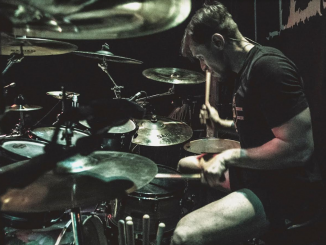Cameron Fleury is an accomplished drummer with solid experience in the Canadian metal scene. Cameron has put his musical talent to work filling in as a drummer on international tours and professional studio recording sessions.
We always see drummers playing in recording studios, but what we don’t see is how they prepare for the studio. In this video I talk about the following topics: metronome/click, learning your parts, your gear and drum tuning.
1: Metronome / Click:
If you don’t know what this word means, then you’re definitely not ready to spend your hard earned money at a recording studio. A metronome is a device that produces an audible click or other sounds at a regular interval that can be set by the drummer or user, typically in beats per minute (BPM).
Learn how to practice with it, and master the click. Only then will you have no problem playing on any session that is thrown your way.
If you feel that a metronome is too robotic and ruins the feel of your playing, then you need to practice with it more and learn how to maneuver your feel throughout its pulse. Whether you’re before, on, or after the beat.
2: Learn Your Parts:
There’s nothing worse than going into a studio when the engineer has spent countless hours setting up the mics. You’re ready to cut your drum tracks, but you can’t seem to remember the first bridge going into the chorus. How embarrassing would that be?
You need to know your parts in and out, with and without the band. Might I suggest that you practice your parts to a metronome by yourself before you decide to book your next studio session. If you can’t play it on your own you are not ready.
Get your guitar player to cut you some rough demos recorded on their phone, so that you can put in some practice time in preparation for the studio. Believe me, you’ll walk into the studio and lay down all your tracks in far less time.
3: Gear
It’s obvious that not everyone can afford top of the line drum gear. However, it is important that when you’re going into the studio that your drums be tuned up properly, and your drum skins don’t look like the surface of the moon. If you still have the same drum skins on since you bought the kit 5 years ago, then maybe you should look into getting new ones.
You do not want to re-skin your drums the night before your session. This will not allow enough time for your drumhead to seat properly on the shell. Please give yourself a few days (with playing) for them to adjust.
Since we’re on the topic of gear, your cymbals should be in good condition too, meaning – don’t bring a cymbal with an awful crack in it because it won’t make your drum tracks sound any better. With that being said, you should also bring cymbal stands that’ll stand upright, and not stands that’ll fall over after one drum take. That could be a nuisance and you could potentially ruin the sound engineers beautiful drum mic collection.
4: Tuning
DRUM TUNING! This is a very important step in regards to recording drums. If you haven’t seen my tom tuning video you can find a link to that video in the description below.
Now, remember, when moving your drums from a warm environment to a cold one, and back to a warm one it will gravely affect the tuning of your drums. So remember, if this is the case to bring a drum key to ensure that your drums didn’t go out of tune in transportation, and to give them a once over before you go ahead and track drums with the engineer.
Cameron Proudly Plays:
Mapex Drums:
Los Cabos Drumsticks:
http://www.loscabosdrumsticks.com
Cameron’s Links:
Cameron’s SDM Vlog: https://sickdrummermagazine.com/category/news/lessons-advice/cameron-fleury-vlog/
Facebook: https://www.facebook.com/camondrums
Instagram: https://www.instagram.com/camondrums
Patreon: https://www.patreon.com/cameronfleury
Don’t forget to subscribe AND smash the notifications bell.
Subscribe Here: https://goo.gl/fVbf2s
Quick Tom Tuning Video: https://www.goo.gl/kmcaoj
Drum Lesson Playlist: https://www.goo.gl/6GU6XK
Contact: c.fleury656[at]gmail.com





Leave a Reply